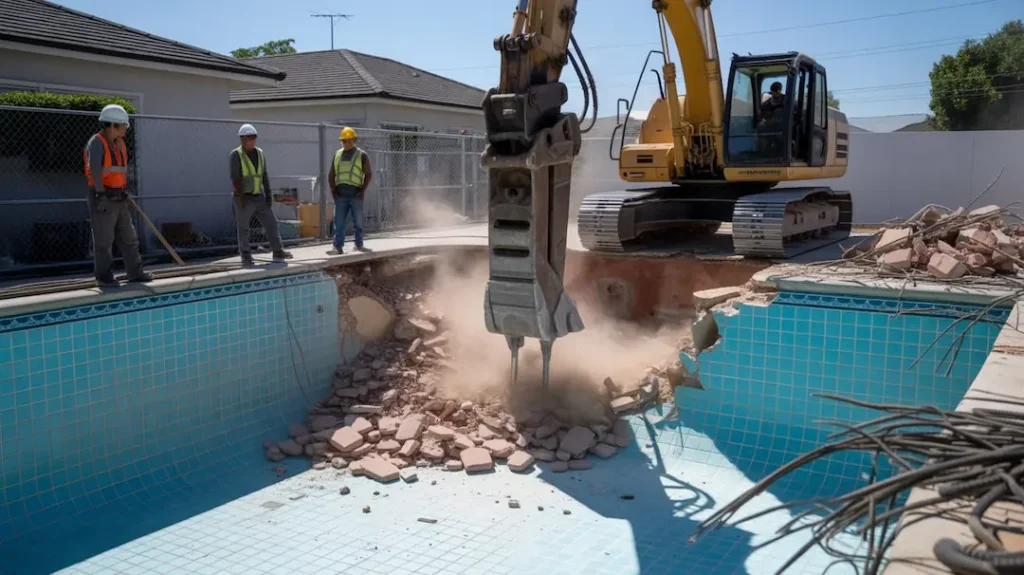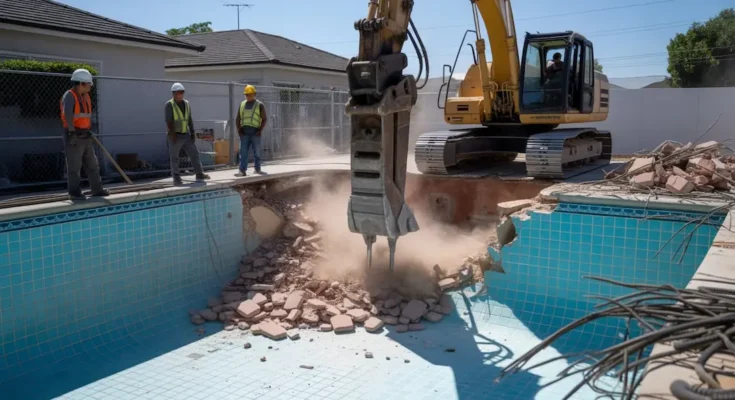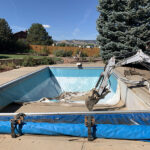If your old pool has become more of a burden than a luxury, you’re not alone. Many homeowners are choosing swimming pool demolition as a practical way to reclaim valuable yard space, reduce maintenance costs, and eliminate safety risks. Whether your pool has structural issues, is too expensive to maintain, or simply doesn’t fit your lifestyle anymore, knowing how to plan a pool demolition properly can save time, money, and stress.
Below, we’ll walk through the entire process—from understanding your options to hiring the right demolition contractor—so you can make an informed decision about your swimming pool removal project.

Content
- 1. Understand Why You’re Removing Your Pool
- 2. Choose Between Partial and Full Pool Demolition
- 3. Get the Necessary Permits
- 4. Hire an Experienced Demolition Contractor
- 5. Drain and Prepare the Pool
- 6. Demolition and Removal Process
- 7. Backfilling and Land Restoration
- 8. Cost Factors to Consider
- 9. Environmental and Safety Considerations
- 10. Enjoy Your New Outdoor Space
- In summary:
1. Understand Why You’re Removing Your Pool
Before scheduling a pool demolition, it’s important to clarify your goals. Some common reasons for swimming pool removal include:
- High maintenance and utility costs.
- Structural cracks or leaks in the pool shell.
- Desire for more usable backyard space.
- Safety concerns with young children or pets.
- Preparing a property for sale or renovation.
By defining your reasons early, you can determine which type of demolition and restoration best suits your situation.
2. Choose Between Partial and Full Pool Demolition
There are two main types of swimming pool demolition:
Partial Pool Removal (a.k.a. Pool Fill-In):
This is a faster and more affordable method where the top section of the pool (about 18–36 inches) is broken down, and the remaining cavity is filled with clean soil and gravel. While this method is cost-effective, it may limit future property use, as some municipalities restrict building over a partially removed pool.
Full Pool Removal:
In this approach, the entire pool structure—concrete, rebar, and liner—is removed. The area is then backfilled and compacted to restore natural ground stability. Although more expensive, a full pool demolition allows unrestricted use of the land afterward, making it ideal for future landscaping or construction.
3. Get the Necessary Permits
Every city or county has its own regulations for swimming pool removal. Before starting, contact your local building department to learn about required permits, inspection processes, and disposal guidelines. Your demolition contractor can often handle this paperwork on your behalf, ensuring the project meets all safety and environmental standards.
4. Hire an Experienced Demolition Contractor
Choosing the right demolition contractor is one of the most important steps in a successful pool demolition. Look for professionals who:
- Are licensed, bonded, and insured.
- Have specific experience with swimming pool demolition projects.
- Use proper equipment and adhere to local codes.
- Provide clear timelines, cost estimates, and cleanup plans.
Ask for references or photos of previous swimming pool removal work to verify quality. A reliable contractor will walk you through the process, from draining the pool to restoring your yard.
5. Drain and Prepare the Pool
Before demolition can begin, the pool must be safely drained according to local water disposal laws. This step prevents flooding and contamination of storm drains or nearby properties. Once drained, your contractor will disconnect utilities such as pumps, filters, lights, and plumbing lines.
For concrete or gunite pools, access points are established for heavy machinery. This preparation ensures that pool demolition work proceeds smoothly and safely.
6. Demolition and Removal Process
During swimming pool demolition, contractors typically use excavators, jackhammers, and hauling equipment to break apart the structure. The debris is either crushed and used as fill material (for partial removals) or hauled away for proper disposal (for full removals).
Once the pool materials are removed, the area is filled with clean dirt, sand, or gravel. The soil is compacted layer by layer to prevent future sinking or uneven settling. This step is crucial to ensure a stable and level surface for future landscaping or construction.
7. Backfilling and Land Restoration
After the swimming pool removal is complete, the focus shifts to restoring your yard. Many homeowners take this opportunity to install new landscaping, patios, lawns, or garden beds. Compaction tests may be required to verify the stability of the soil, particularly if you plan to build a structure in the area later.
A professional demolition contractor can also help with grading and drainage to ensure water flows away from your home’s foundation.
8. Cost Factors to Consider
The cost of pool demolition varies based on factors such as:
- Pool size, depth, and material (concrete, fiberglass, vinyl).
- Type of removal (partial vs. full).
- Accessibility for heavy machinery.
- Local disposal and permit fees.
On average, swimming pool removal costs range from a few thousand dollars for a small partial demolition to tens of thousands for large or complex removals. Getting multiple quotes helps you find a fair price and avoid hidden charges.
9. Environmental and Safety Considerations
Responsible pool demolition also involves proper recycling and disposal of materials like concrete, rebar, and piping. Many contractors recycle debris to reduce environmental impact. Safety measures such as fencing and dust control should be in place throughout the project to protect your property and neighbors.
10. Enjoy Your New Outdoor Space
Once the swimming pool demolition is complete, your backyard can be transformed into something new—a garden, deck, playground, or expanded lawn. With the help of an experienced demolition contractor, the process can be efficient, safe, and rewarding.
In summary:
A well-planned swimming pool removal can improve your property’s functionality, appearance, and value. By understanding your options, securing permits, and hiring the right professionals, you’ll ensure your pool demolition project goes smoothly from start to finish.

Christine Kelley is a dedicated home blogger who has been blogging for over six years. She covers everything home related. Christine also loves writing posts about her travels to Europe with her husband and two children.



